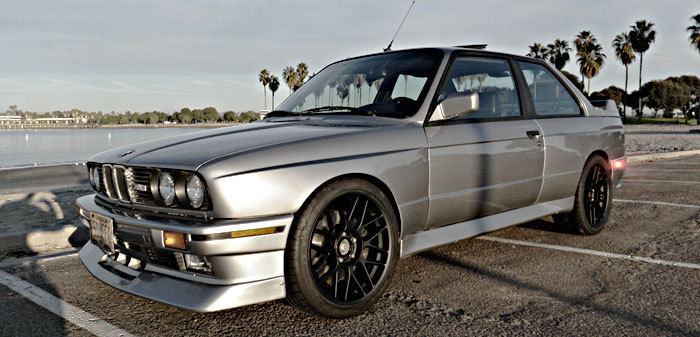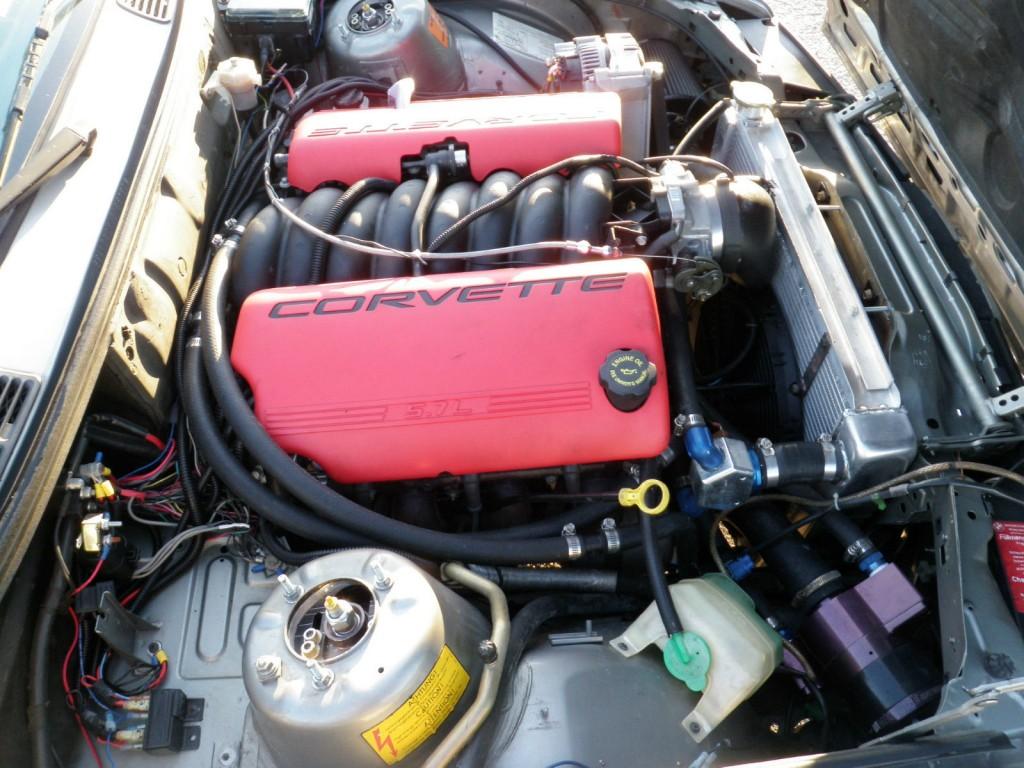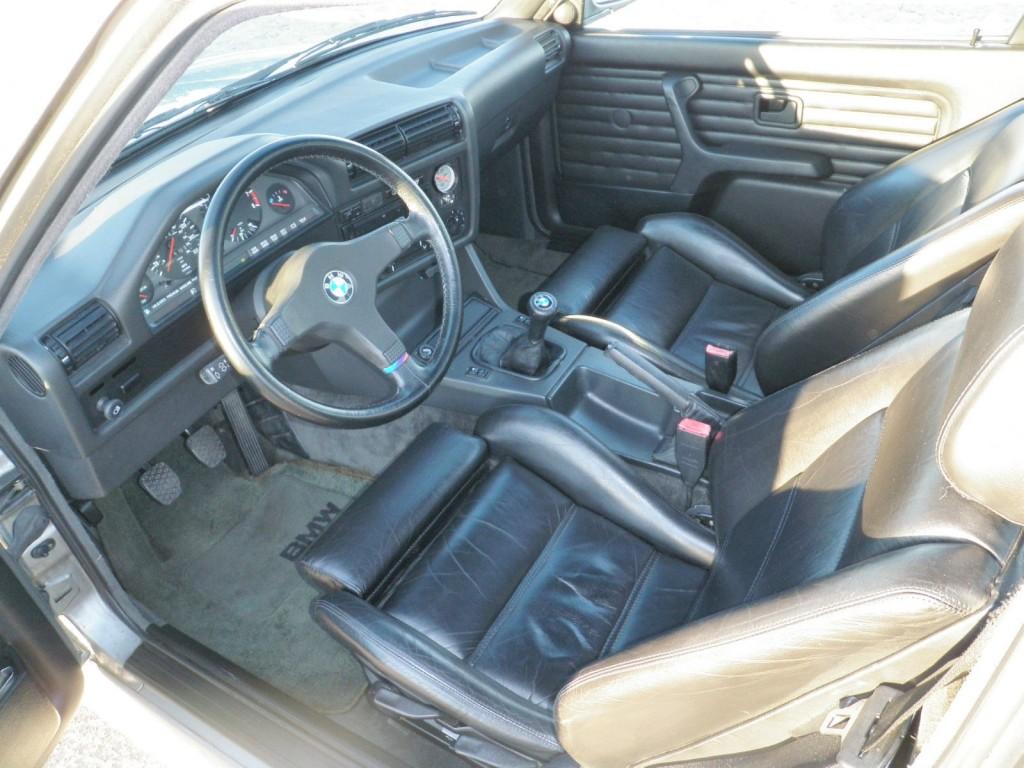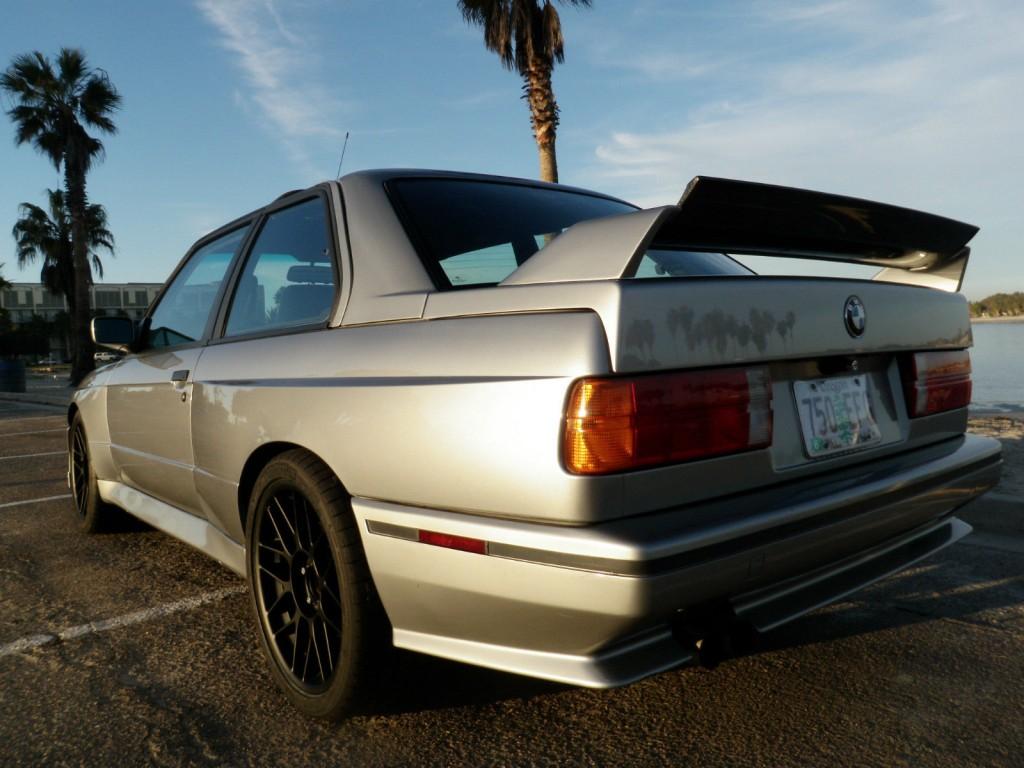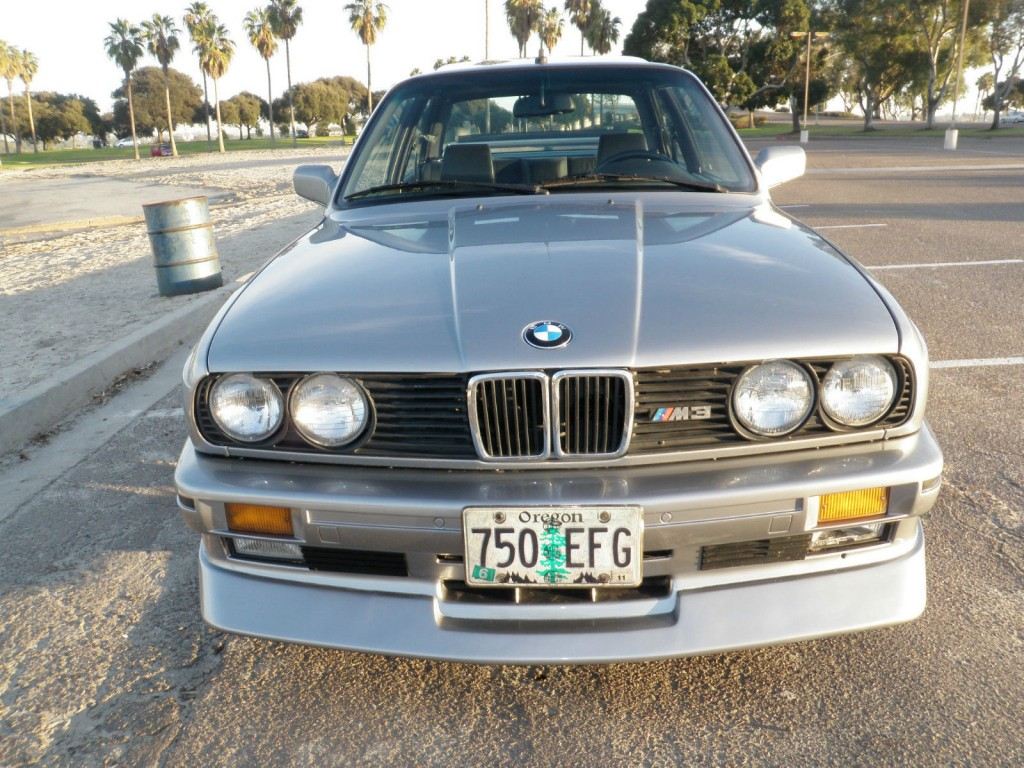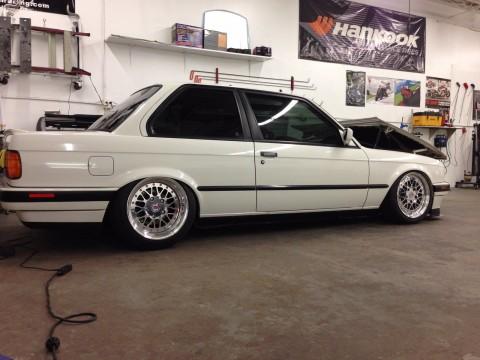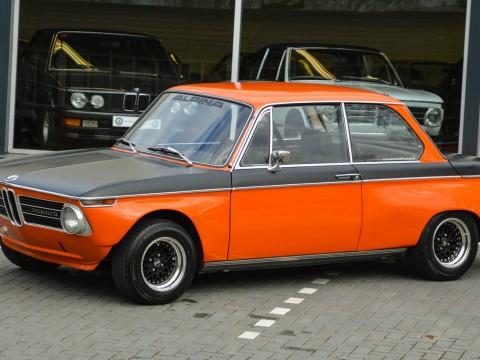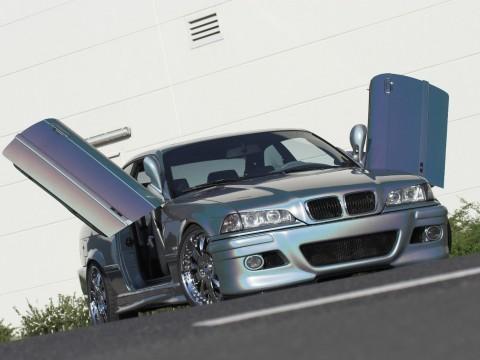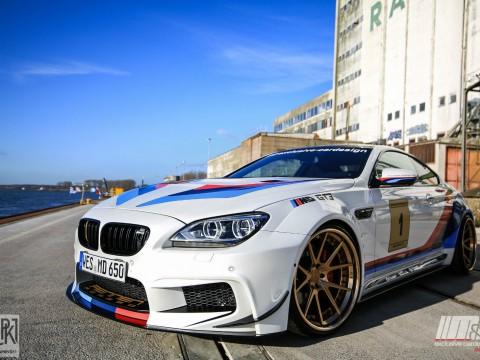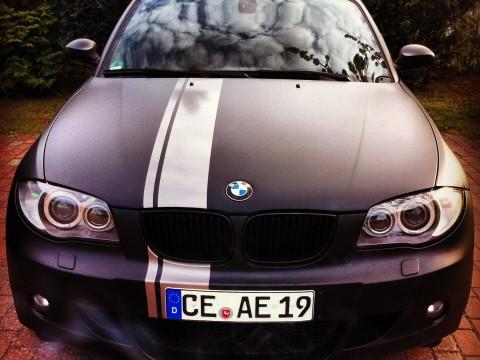BMW E30 M3 with an LS1/6 Corvette engine & Camaro 6-speed tranny. The LS1/2/6/7 GM engines are an engineering marvel of low weight, high power, emission friendly, easily hotrodable aluminum, plastic and computer. 7. Installing an LS1/2/6/7 engine into an E30 is no more expensive and no more work than installing an M50 or M52 engine. 8. The total weight gain over an E30 with an S52 engine is about 50# but with over twice the hp and torque of the S52. This little 450 hp beast has brought my wildest fantasies to reality. It idles like a well tuned 36 hp VW engine. It has instant throttle response and tremendous, smooth, power with no low end lag. It has a good, civil but obviously not stock, sound, and it looks like an original, pristine, bone-stock ’88 M3 inside and out except for lowering, aftermarket wheels/tires, larger exhaust tips and, of course, the engine compartment. Since then i have added a aux 20 gal fuel cell, bbs wheel, 3.5 inch straight exhaust , dyno tuned it, new radiator, front bumper kit, rear wing, 450 horse power. If you paid yourself a buck an hour to build this car you’d be in it $50,000. If you paid someone else to build it you’d probably spend $75,000 or more. The first step was to obtain, in this case rent, one of those foam replicas of a small-block Chevy engine and a tranny and make a trip to the local junkyard that contained a few E30 chassis’. Imagine the looks you’d get walking through a junkyard on a Saturday afternoon with an engine under one arm and a transmission under the other. Anyway, it became obvious that there was plenty of room in an E30 engine bay for a small-block Chevy so I knew the LS1/6 would also fit. A T-56, 6-speed, aluminum Camaro/Firebird tranny bolts-up to the LS1/6, measurements indicated it would fit well, was light weight and the gear ratios were perfect, i.e. 60 mph at 1700 rpm in 6th. The 212 mph at 6000 rpm won’t be of much use for me.
When I say LS6 or ZO6 I must confess that is only for bragging rights and hp identification. The engine is actually a new LS1 I purchased. 99% of the parts on the LS1 and LS6 are identical and by changing the cam, doing some head work and adding an LS6 intake manifold the LS1 can produce more power than the stock LS6/ZO6.Once the new engine and new Camaro aluminum 6-speed transmission were purchased I was committed. When I raised that engine and tranny up into the chassis I had to pinch myself it fit so well. The shifter actually fit exactly in the center of the hole in the tunnel where the original BMW shifter was. I did end up moving the entire unit ¾” back to improve the overall configuration. In order to move it back and get the engine as low as I wanted to in the chassis, I had to modify a front sump GM Holden Australian oil pan. It looks like this engine and tranny were made for this car. The weight of the engine and tranny is very little more than an iron-block, BMW, 3.2, M3, 6 cylinder engine and tranny, which is a popular swap, so brake and suspension modifications are not necessary although I did install E36 M Roadster/Coupe front and rear suspension with larger brakes, larger bearings and strengthened rear control arms. The swap is almost bolt-on. Since the M Roadster/Coupes weigh around 3100#, this car at about 300# less has much more than adequate brakes. The entire balance and feel of the original E30 M3 should be retained but with about twice the horsepower and torque and without having to rev the engine to 7500 rpm to get the ponys. The certified weight of the finished, driving car is 2850# with A/C, spare tire, jack and tools and a full fuel tank. The front wheels support 1510# and the rears 1310#. I guess friction in the scale is why the two weights don’t add up to 2850. Who knows? If I subtract the weight of the fuel, 16 X 8 = 128#, remove the spare tire, jack and swap in my 13# Hawker battery I should weigh in at something near the 2600# + range. The gear ratios (2.66, 1.78, 1.30, 1.00, .74, .50) are perfect for the stock 4.10 limited slip diffBecause I’ve installed ’00 M Roadster/Coupe front & rear suspension no spacers were needed. At 60 mph in 6th gear the engine is at about 1700 rpm if my math and the tach are correct. It is a very comfortable freeway cruiser! I installed Ground Control front and rear fully adjustable Koni shocks and their coilover kit with adjustable camber plates and went with their recommendations for springs and shock adjustment and I’m extremely happy with the ride. I reversed the camber adjustment plates so I could get more tire clearance at the rear of the front tires. I told GC my intended use was street performance and not race track. You might want stiffer springs for track use. I’m sticking to the stock anti-sway bars as the car corners pretty flat as is. Mild modifications such as a McLeod aluminum flywheel with Corvette clutch (I love quick revving engines), 222/226 @ .050, .569”/.569” cam, up-graded valve springs, re-flash PCM and mild headwork (about 20 hours of my own time) should put about 400 hp to the rear wheels (450 at the flywheel) and that should satisfy any M3 nerd; even me. I spent a lot of phone time with a guy named Chris at Katech Engineering (GM Corvette racing department), picking his brain, so I could build an engine with the characteristics I wanted for a high performance street driver. The differential is the stock M3, 4.10, limited-slip unit and, along with the E36, M Roadster half-shafts the rear end of the drive train seems to be more than strong enough.I completely disassembled the new engine to check everything out and to blueprint it. I installed Katech rod bolts, ported the oil-pump, installed ARP head-studs and main bearing studs, up-graded the timing gears (Cloyes) and chain (HME-G68VC-60) from Katech, Comp Cams chrome molly pushrods, modified a GM Holden front sump oil pan so it would clear the front cross member and steering rack, installed a carefully selected cam, (569” intake and exhaust lift, 222/226 duration @ .050”). The cam is considerably more radical than a stock LS6 cam but I took Chris’ (from Katech) advice and it turned out perfectly. I checked the specs. of many, many valve springs and settled on Lunati PN# 73100 with Ferrea titanium valve spring retainers (these pieces are absolute jewelry). I cut the valve spring pockets in the heads for the new springs and installed hardened steel spring cups under the springs when I set them up. The cooling system is functioning very well. The engine has no tendency to overheat unless I sit at a stoplight or behind a school bus for too long and then I just flip the electric fan switch and it cools right down. I’m using a Meziere remote electric water pump (pn# WP 316 S, 55 gpm) mounted in front of the windshield washer fluid container behind the right headlights, a Summit Racing aluminum radiator pn# 380425, and the stock BMW electric fan wired to a switch on the dash. I fabricated aluminum adapters from ½” alum. plate to fit the water inlet and outlet holes in the block (Meziere now makes them) and welded Earls 90 degree aluminum, ¾” hose barb fittings into them for my water lines. I used a Meziere “Y” fitting to collect the hot coolant from the heads in ¾” heater hoses and then to the radiator through 1 ¾” radiator hose. Since the 1 ¾” Meziere hose barb and the radiator inlet butted up next to each other inside the hose I filed a little material out of the inside of the hose barb so a Prestone 357-180 thermostat would slip into it and then ground the outside edge of the thermostat down until it was about 1 ¾” in diameter. When I installed the 1 ¾” radiator hose between the hose barb and the radiator the thermostat was captured and held tightly. I then tightened a stainless steel hose clamp in the middle of the hose so coolant wouldn’t escape around the thermostat. The heater hoses have to be attached to the correct BMW inlet and outlet heater core tubes if you want your heater to produce heat. The heater works flawlessly.I installed a new GM AC compressor in the stock location, figured out all of the refrigerant lines and fittings but I haven’t hooked it up yet.The exhaust system consists of stock stainless GM headers from a ’97 – ’99 Corvette, cut and modified with 3” down pipes connecting to 3” tubing back to the custom muffler. The motor mounts are stock Camaro units cut, modified, boxed and welded using ¼” plate to mate up to the mounting points on the BMW cross member. The rubber and steel transmission mount is also a stock Camaro unit and it is attached to the frame and transmission with some custom fabricated pieces of angle iron. It seems to be very strong. The in-the-tank fuel pump is a Walbro GSS 342 fastened to the stock BMW fuel pump mounting bracket with a stainless steel hose clamp. I’m using the stock external pump and all stock fuel lines too. I was able to use a stock Camaro clutch master cylinder with the stock BMW pedal after some minor modifications and I was able to do the same with the brake and gas. I had to change the brake pedal ratio because I discarded the power and ABS brakes. I used a Wilwood 1” aluminum tandem brake master cylinder.I had a machinist turn a ½” thick disk of aluminum to adapt a custom driveshaft flange to the M3 diff. input flange. It fit perfectly. To obtain adequate clearance between the rear U-joint and the gas tank I partially unbolted the diff. and placed washers of about 1/8” thickness under the two forward diff. mounting bolts and re-tightened all four bolts. That tilted the diff. nose down just enough to give the rotating u-joint adequate room to spin. I have added a 20 gal aux fuel tank with remote fuel pump, bbs wheels with michelin tires, front air damp and a carbon fiber rear wing to give it a more euro tuner look. there is approx 30k miles since conversion.
Price: Auction
More info: Listing has ended. Click to search on eBay for similar 1988 BMW M3 (Affiliate link)
Location: San Diego, California, United States
